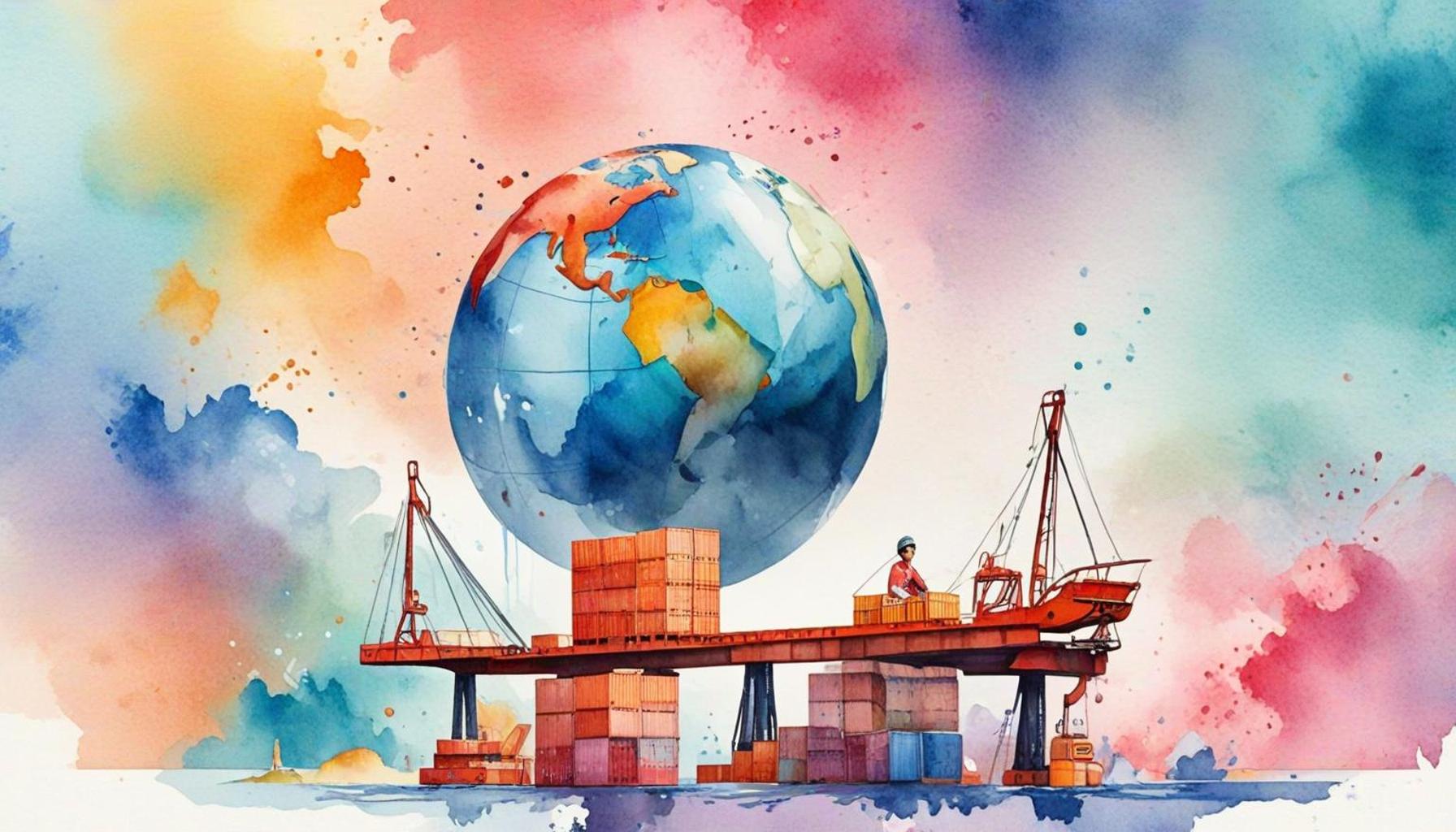International Economy and Trade Balance

The Significance of Trade Components in Economic Stability
The intricate web of the international economy influences nations in multifaceted ways, shaping policies and impacting the livelihoods of millions. As trade across borders becomes increasingly prevalent, understanding the dynamics of trade balance is crucial for economic policy and business strategies. It is essential to delve into the various components of international trade to grasp their implications fully.
Core Components of International Trade
Key components to consider in the international economy include:
- Exports: Goods and services sold to foreign countries. Exports are vital for generating income and stimulating domestic production. For example, American technology firms like Apple and Google have expansive global markets, significantly bolstering U.S. exports.
- Imports: Goods and services purchased from foreign countries. Imports allow consumers access to diverse products and services, often at lower prices compared to domestic alternatives. For instance, American households widely use imported electronics and clothing, resulting in a rich variety of choices for consumers.
- Trade Balance: The difference between a country’s exports and imports. A positive trade balance, or surplus, occurs when a nation exports more than it imports. This can enhance a country’s economic standing by increasing national earnings and employment potential.
The Implications of Trade Balance
A favorable trade balance can contribute to national economic health. For instance, in recent years, the United States has experienced varying trade balances with significant partners, such as:
- China: Historically, the U.S. has run a substantial trade deficit with China, which has drawn attention to concerns regarding manufacturing jobs and currency manipulation.
- Canada: The U.S. normally enjoys a trade surplus with Canada, thanks to the robust trade in energy resources, agriculture, and machinery, which has beneficial implications for cross-border investments.
- Mexico: Similar to Canada, trade with Mexico often shows a positive balance for the U.S. in certain sectors, highlighting the importance of the North American trade agreement frameworks.
These relationships have profound implications for employment, currency valuation, and overall economic health. Changes in trade balances can influence job creation or loss in critical sectors, such as manufacturing or technology, thereby impacting the livelihood of many workers and their communities. Moreover, currency valuation is affected by trade balances too, as a surplus may lead to strengthening a country’s currency, while a deficit can weaken it, influencing international purchasing power.
It is vital for policymakers, economists, and businesses to grasp the importance of maintaining a sustainable trade balance to foster growth and stability. By closely monitoring these dynamics, stakeholders can better craft policies that promote economic resilience in an ever-evolving global landscape.
SEE ALSO: Click here to read another article
The Influence of Global Trade Dynamics on Economic Policies
The interdependence of nations through trade offers both opportunities and challenges that shape economic policies across the globe. Understanding the trade landscape is essential for navigating the complexities of the international economy. This entails not only a thorough analysis of trade balances but also an examination of how external factors influence trade dynamics.
Globalization and Trade Liberalization
The rise of globalization has fundamentally altered trade practices, as countries become increasingly interconnected. Trade liberalization—the reduction of barriers to trade—has facilitated this shift by allowing goods and services to flow more freely across borders. Such changes have led to significant increases in trade volumes, benefiting economies through enhanced competition and innovation. For instance, the implementation of policies such as the North American Free Trade Agreement (NAFTA) significantly boosted trade between the United States, Canada, and Mexico, resulting in an increase in cross-border investments and economic collaboration.
Crisis and Trade Balance Fluctuations
Trade balances, however, are susceptible to fluctuations driven by both domestic and international factors. Economic crises, such as the 2008 financial crisis, illustrate how external shocks can lead to significant downturns in international trade. The crisis resulted in a rapid contraction of consumption and investment, negatively impacting exports for many nations, including the United States. Consequently, understanding the interplay between economic downturns and trade balance shifts is essential for policymakers aiming to mitigate adverse impacts.
Several factors can disrupt the equilibrium of trade balances:
- Exchange Rates: Fluctuations in currency values can either benefit or hinder export competitiveness. A strong domestic currency may deter foreign buyers, while a weaker currency can make exports more appealing, thus affecting trade balance.
- Tariffs and Trade Barriers: Imposition of tariffs by one nation can provoke retaliatory measures, leading to disrupted trade flows. For instance, the recent trade tensions between the United States and China highlight how tariffs can lead to a deterioration of relationships and affect overall trade balances.
- Supply Chain Disruptions: Events such as natural disasters or a pandemic can cause significant disruptions in production and logistics. The COVID-19 pandemic, for example, brought widespread interruptions that impacted trade globally, affecting both exports and imports.
Given these variables, a comprehensive understanding of the international trade environment is pivotal for creating effective economic policies. Policymakers must remain vigilant and adaptable to changes in trade dynamics to safeguard economic stability and promote growth. Establishing mechanisms for data-driven analysis and assessments will enable a more proactive approach towards managing trade balances and ultimately strengthen the economic landscape of nations.
SEE ALSO: Click here to read another article
The Role of Trade Agreements and Regional Cooperation
Trade agreements have emerged as crucial instruments for shaping international economic relations and achieving balanced trade. With the aim of reducing barriers and fostering cooperation, these agreements can significantly influence trade balances by establishing favorable conditions for trade among partner nations.
Multilateral and Bilateral Trade Agreements
Multilateral trade agreements, such as the World Trade Organization (WTO) agreements, provide a platform for member countries to negotiate trade rules and resolve disputes. These agreements not only focus on tariff reductions but also cover a myriad of issues such as intellectual property rights, services, and investment. They aim to create a level playing field, fostering fair competition that can enhance trade balances. In particular, the WTO plays a vital role in promoting transparency and predictability in international trade, which is essential for businesses operating in a global marketplace.
Bilateral trade agreements also play a significant role in shaping trade dynamics. The United States has entered into numerous bilateral agreements, such as the one with South Korea, which has strengthened trade links and increased U.S. exports to the region. These agreements often contain provisions that specifically enhance trade in goods and services, thus improving trade balances between the participating countries. In many cases, such agreements can serve as strategic tools to strengthen economic ties and reduce trade deficits.
The Impact of Emerging Markets
The rise of emerging markets is another key factor influencing global trade dynamics and trade balances. Nations such as China, India, and Brazil have experienced significant economic growth over the past few decades, becoming major players in international trade. Their integration into the global economy has led to increased demand for raw materials and intermediate goods, thereby providing opportunities for developed economies to enhance their exports.
However, this growth has also contributed to trade imbalances. For instance, the United States has faced persistent trade deficits, particularly with China, as a result of the large volume of imports. This situation has prompted policymakers to seek adjustments in trade relations, reflecting the need to balance the benefits of engaging with fast-growing economies against the drawbacks of adverse trade balances.
Technological Innovations and E-commerce
Advancements in technology and the growth of e-commerce have reshaped trade dynamics in unprecedented ways. Businesses can now engage in cross-border trade more efficiently, with digital platforms facilitating access to global markets. As a result, the volume of goods traded internationally has surged, impacting trade balances positively for certain nations. For instance, American companies leveraging e-commerce have found new avenues for exporting products, thus contributing to better trade performance.
Digital trade agreements are emerging to address the nuances of e-commerce, ensuring that digital transactions are facilitated and protected across borders. The United States has taken steps towards establishing frameworks that promote digital trade, recognizing the potential benefits for economic growth and trade balance improvement. As digital commerce continues to expand, understanding its implications for trade will be crucial for policymakers looking to maintain balanced trade relationships in a rapidly evolving economy.
In conclusion, the interplay between trade agreements, the rise of emerging markets, and technological advancements underscores the complexity of managing trade balances. Policymakers must remain responsive and innovative in addressing these challenges, ensuring that the international economy thrives amidst ongoing changes. Establishing a strong strategy for international trade will be vital for achieving desired economic outcomes and maintaining global competitiveness.
SEE ALSO: Click here to read another article
Conclusion
In summary, the landscape of the international economy and trade balance is increasingly intricate, shaped by multifaceted factors such as trade agreements, the influence of emerging markets, and the rapid evolution of technology. As global trade relationships become more interdependent, effective management of trade balances is essential for sustainable economic growth. Policymakers must prioritize the formulation and implementation of trade strategies that not only promote exports but also address trade deficits, particularly in sensitive contexts like that of the United States, which grapples with substantial trade imbalances with several key partners.
Furthermore, as emerging markets like China and India continue to expand their economic prowess, the U.S. faces both challenges and opportunities for enhancing its trade performance. Engaging strategically with these nations can unlock new markets for American products while ensuring that trade policies foster fair competition and equitable outcomes. Additionally, the rise of e-commerce and technological innovations underscores the necessity for adaptive frameworks that respond to the unique demands of a digital economy, ensuring that American businesses can effectively participate in global trade.
Ultimately, a balanced international economy hinges on the ability to navigate these complexities with foresight and flexibility. By fostering collaboration through innovative trade agreements and embracing the potential of digital trade, policymakers can steer the country towards improved trade balances and enduring economic prosperity.

James Carter is a financial writer and consultant with expertise in economics, personal finance, and investment strategies. With years of experience helping individuals and businesses navigate complex financial decisions, James provides practical insights and analysis. His goal is to empower readers with the knowledge they need to achieve financial success.





